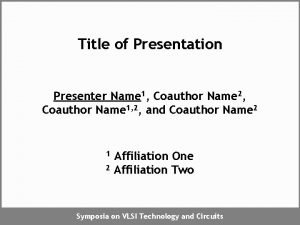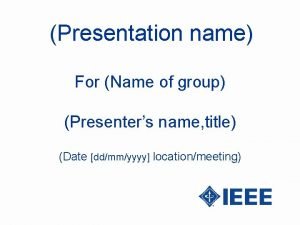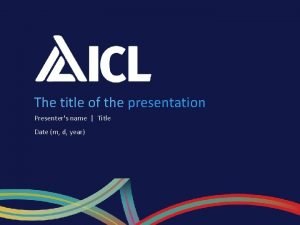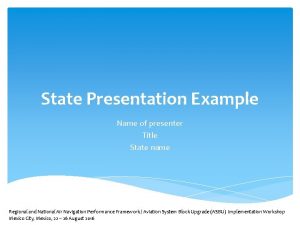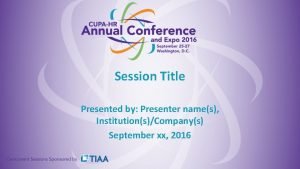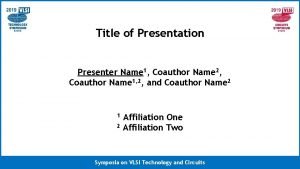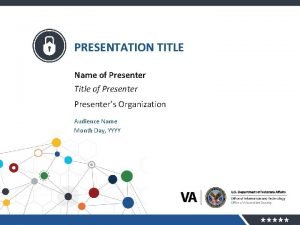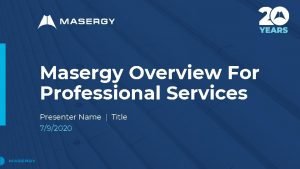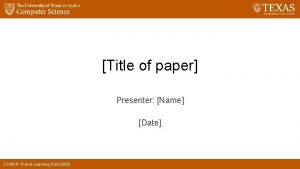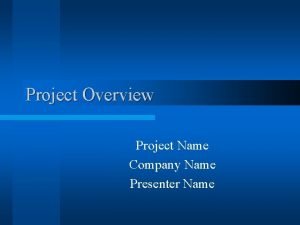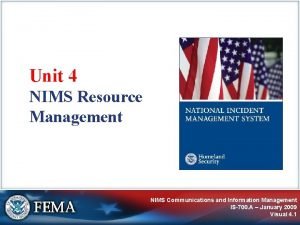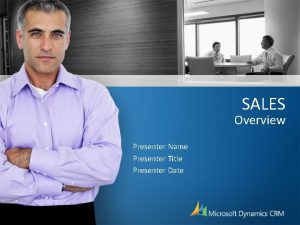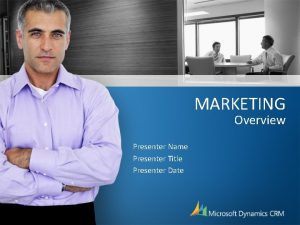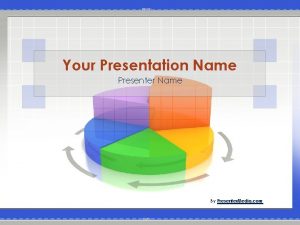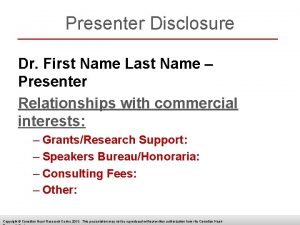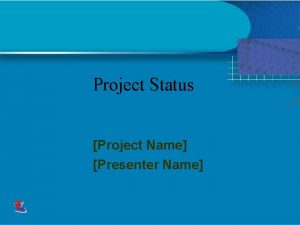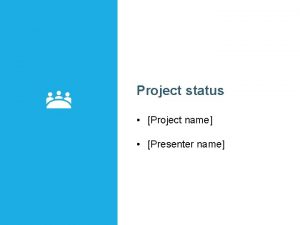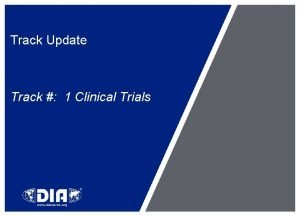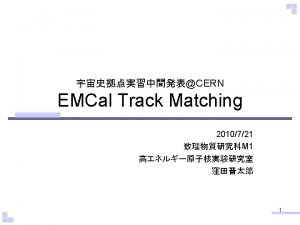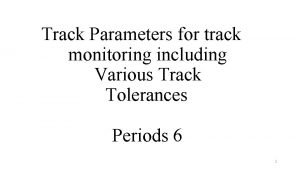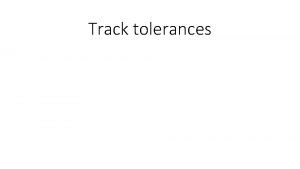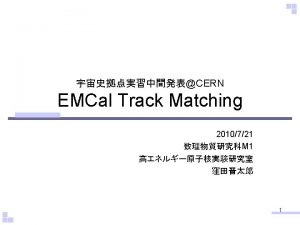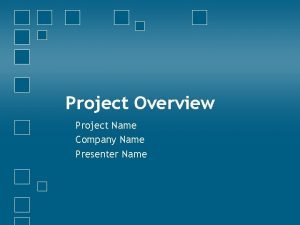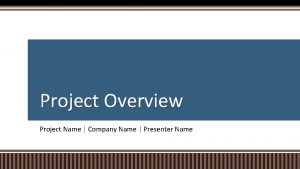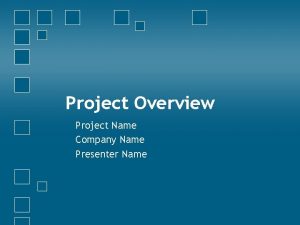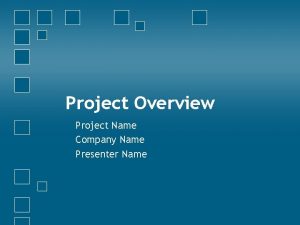Track 1 summary report Presenter Name The Track































- Slides: 31

Track 1 summary report Presenter Name The Track 1 coordinators Luis Salinas, Axel Naumann and Niko Neufeld The Track 1 advisors David Britton, Jerome Lauret, Clara Gaspar ACAT 2016 18 -22 January 2016 UTFSM, Valparaíso (Chile) Computing technology for Physics Research Summary by Niko Neufeld and Graeme Stewart

Introduction • • Track 1 had a lot of high quality contributions They cover a very wide field of software and hardware techniques and technologies • A selection will be presented and some synthesis attempted “Not mentioned” does not mean “not interesting” 2

Statistics • • • 39 abstracts submitted (1 moved to plenary) 20 talks accepted, 1 short-term cancellation 17 posters accepted out of which 15 were actually shown 3

Fabrics, infrastructure, power, data-placement, workload engines and all that… 4

Managing power • Introduce hibernation policy power savings • Can be made more efficient using preemptible jobs • Adapting to varying prices cost saving • How to properly integrate what the users really want? Jobs starting promptly Jobs waiting in queue Machine Online • Machine Offline Hibernate if: • Machine has been idle for 5 minutes • At least 30 minutes since last wakeup • Machine COULD start jobs • Do Nothing • Wake machine if: • At least 30 minutes since last hibernation 35% idle 90% half-loaded(!) Greg Corbett “Reducing power consumption on demand” 5

Konrad Meier “Dynamic provisioning of a HEP computing infrastructure on a shared hybrid HPC system ” CM Ce S “ E ntr las e r tic eso ext urc ens es i on on of ext a ern CM al C S Co lou mp ds” uti ng Using HPC resources 6

Using HPC resources II Markus Fasel “Using NERSC High-Performance Computing (HPC) systems for high-energy nuclear physics applications” • HPCs not generally the best suited resources to our problems • However they do exist and we do have access to them • Running here can bring considerable resources • Standardisation…? See also posters “Integration Of Pan. DA Workload Management System With Supercomputers for ATLAS and Data Intensive Science” “Scaling up ATLAS Event Service to production levels on opportunistic computing platforms” 7

Gang Qin, Dave Britton et al. “Cluster optimisation using Cgroups” • Containment of job resources using cgroups • Careful monitoring of many jobs • Have observed minimal < 2% runtime impact by limiting resident memory to 75% of requested (needs to be validated for different workloads) On this basis, we reduced memory allocation of all single core jobs to 1. 8 GB for the last 6 months: Running was stable. We achieved 10% higher CPU usage. For detecting problems see also: Eileen Kuehn, Manuel Giffels “A scalable architecture for online anomaly detection of WLCG batch jobs” 8

Ma Co x Fisc o Pro rdin her, ces ated Ma n sin g ” Cach uel G ing iffe for ls “ Dis Da trib ta L ute oca lity d via Use data-popularity for caching 9

Storage Federation Locality of meta-data / EOS federation Metadata @PNPI (local) pnpi-pnpi Ale x Coo ei Klim Pro rdinate emtov ces sing d Cach “Data ing L ” for ocality Dist ribu via ted Metadata @CERN (remote) pnpi-cern-pnpi xrootd fuse spbu-pnpi spbu-cern-pnpi seconds 0 • 1000 2000 3000 4000 5000 6000 7000 8000 Legend – – PNPI-PNPI : client@PNPI, data@PNPI, MGM@PNPI-CERN-PNPI: client@PNPI, data@PNPI, MGM@CERN SPBU-PNPI: client@SPBU, data@PNPI, MGM@PNPI SPBU-CERN-PNPI : client@SPBU, data@PNPI, MGM@CERN 10

Fedor Prokoshin “The ATLAS Event. Index: data flow and inclusion of other meta-data” Event. Index uses 350 B/ event Allows event-picking and counting and duplicate detection: Uses Active. MQ and central Hadoop infrastcture at CERN Objective: Find the data I want! 11

Valentin Kuznetsov , Daniele Bonacorsi “predicting CMS dataset popularity” “Will these data be popular? ” Related study done in LHCb Nikita Kazeev “LHCb data processing optimization using Event Index” 12

In a world with thin pipes, varying CPU and disk resources and network links: How do we best schedule processing? Dzmi tr Simu y Makatu la n appr tions and “Multi-r oa e s High ch for di tudy of a source pl st an Energ n y and ributed d ew sched ning: ata ul Nucle ar Ph product ing ion in ysics ” All you need is a (better) plan Forwarding allows using full topology of scientific internet 14

Large scale simulation of planner 11 sites 50 k. CPUs 500 k jobs Much higher CPU utilization Adaptive! 15

Leveraging the resources in the Online clusters Mich Data ael Poat Dist Placem “Perfor ribu ted ent Tech mance a Stor age niques nd Adv a w Syst em” ith Cep nced h’s • Move processing toward online domain requires storage (Online QA, real-time calibration, …) • Users can store and recover data to a local storage while running jobs – “a” global space helps share results across processing nodes • Distributed file system & aggregators exists (Xrootd, Object storage, …) – users most familiar with POSIX FS. CEPHFs offers Posix FS w/o single point of failure In practice: • Very stable performance survived even DNS breakdown • Study judicious use of SSD the use-case needs to be demanding enough to see advantage • CEPH has no single point of failure, but CEPHFS seems to be only as fast as the weakest 16 performing component!

Triggers soft vs hard – the debate continues 17

Naoki Kimura “ATLAS FTK a - very complex - custom parallel supercomputer” New and better triggers 18

Towards 99. 99 offline quality in LHCb triggers Joha n trigg nes Alb re er in Run cht “Th e. L 2” HCb High Leve l For CMS future trigger see poster by D. Cieri “Hardware Demonstrator of a L 1 Track Finding Algorithm with FPGAs for the Phase II CMS Experiment” 19

Accelerate me! Make me better! Make me parallel! 20

Geometry performance (Phi vs Xeon) in Geant. V Andrei Gheata “From CPU to accelerators ” • Geometry is 30 -40% of the total CPU time in Geant 4 • 16 particles 1024 particles SIMD max Intel Ivy-Bridge (AVX) ~2. 8 x ~4 x 4 x Intel Haswell (AVX 2) ~3 x ~5 x 4 x Intel Xeon Phi (AVX-512) ~4. 1 ~4. 8 8 x A library of vectorized geometry algorithms to take maximum advantage of SIMD architectures • Substantial performance gains also in scalar mode • Testing the same on on GPU • Moving from prototype to demonstrator 21

Going parallel Goal: write EM models, to deal with multiple tracks , to be accurate, fast and "portable” Algorithms need to be redone – use alias sampling to vectorize pdfs for multiple tracks ics s Phy etic agn rom uting ect “El omp Jun llel C ung Para r n. Y Soo dels fo res ” u Mo hitect Arc 1% agreement with G 4 Speedup on Xeon. Phi >6 x 22

We are better than some of us sometimes think! Shaun Roe, Graeme Stewart “C++ Software Quality in the ATLAS Experiment” 23

G. Stewart “Multi-threaded Software Framework Development for the ATLAS Experiment” Going parallel Athena. MT exploits Memory / core goes down • Multiple event parallelism NUMA become more complex • Inter-event parallelism Memory bandwidth will be key to • In-algorithm parallelism Use CPUs • Uses Intel TBB under the hood Re-training the development community is not easy! Increasing threads improves throughput for a modest memory increase 24

Can physics users go easier and faster…? Use a declatative syntax to make it clearer what you are doing More powerful when combining multiple plots Gord o a Mo n Watts “ dern E Analy xperimen ts sis En viron Toward ment ” Automatic regression tests with Jenkins Not our standard environment, but ideas attractive (c. f. ROOT plenary talk) 25

Beyond LHC and ACAT 16 27

LHC is not the only big fish in the pond… 2 Arrays: North+South All-Sky Coverage Large Size Telescope - LST low energy section Ethresh ~ 10 Ge. V a few ø=23 m telescopes Medium Size Telescope - MST core array 100 Ge. V-10 Te. V ~ 40 ø=12 m telescopes Small Size Telescope SST high energy section ø ~ 40 =6 m tel. on 10 km 2 area Peter Wegner, ACAT 2016, 18 -22 January 2016, UTFSM, Valparaíso (Chile) P. Wegner “The software system for the Control and Data Acquisition for the Cherenkov Telescope Array” More than 30 countries and ~300 M€ of budget. More than 1000 members in the consortium. Including the vast majority of the experts from existing experiments. 28

CTA Array Control and Data Acquisition - ACTL • • • Software based on Alma’s software (see plenary) and OPC UA Operator Information flow ofdiagnosis ‘abstract’, functional data elements System decomposed in functionalities Functions have Operator structure and control granularity Architecture centered, using only COTS hardware 30+ year life-time ACTL System pl le p m xa e e Reporting & diagnosis Sim Configuration Management of HW Status [Timeframe], Alarm Statuslocal data [Timeframe] Operator manual commands Configuration Pars. Monitoring data, System alarm status Scheduling and central control Monitoring & Alarms Telescope commands, resource requests Telescope monitoring, Telescope array alarms status Control of telescope arrays Telescope commands Telescope HW status, telescope alarms 29

F. Rademakers “New Technologies for HEP - The CERN openlab” Many more projects with • Put/Get/Delete/… with a few extra’s • Checksum: can be verified by the drive – No need to read data for scrubbing • Version: test-and-set functionality – Drive-side concurrency resolution Test if we can improve EOS performance 30

Conclusions & synthesis • • Track 1 had a lot of high-quality contributions A lot of hard work went into improving and exploiting things we know: o Better use of computing fabrics, batch-facilities, less power, more CPU for the same money, better user-experience (run-time), exploitation of up-tonow unused resources (HPC, commercial clouds) o Accelerators are moving from the hype-peak to the productivity plateau even if we don’t use a specific accelerator technology, the efforts which went into making them usable for us will make our code better and – in most cases – faster 31

Conclusions and synthesis 2) • We are not alone o Probably not we (human beings) in this universe but more importantly this conference showed (again) that there are other very large, long-lived scientific instruments out there (ALMA, CTA) we can learn from each other o • As well as our own ‘new kids on the block’ (Belle II) In online computing the ever higher data-rates are met with more and more sophisticated hardware (ATLAS, CMS track-triggers) and/0 r with offline-quality near-online data-reduction in software (LHCb) the “debate” between these two approaches will continue 32

Conclusions and outlook 3) • • We didn’t see a game-changer this time round • Looking forward to the next ACAT to see which of them But for sure they are out there, waiting to be discovered will come forth 33
 Name/title of presenter
Name/title of presenter Rgb presenters
Rgb presenters Presenter title
Presenter title Presenter name
Presenter name Presenters name
Presenters name Presentation name
Presentation name Presenter's name
Presenter's name Name of presenter
Name of presenter Name of the session
Name of the session Presenter company
Presenter company Younique presenter ms name
Younique presenter ms name Name/title of presenter
Name/title of presenter Ebcflex app
Ebcflex app Name/title of presenter
Name/title of presenter Presenter's name
Presenter's name Presenter name
Presenter name Name/title of presenter
Name/title of presenter Cs391r
Cs391r Company presenter
Company presenter Name/title of presenter
Name/title of presenter Presenter's name
Presenter's name Name/title of presenter
Name/title of presenter Presenter name
Presenter name Presenter's name
Presenter's name Name all the lines name all the segments name all the rays
Name all the lines name all the segments name all the rays Nims communications and information management
Nims communications and information management Hát kết hợp bộ gõ cơ thể
Hát kết hợp bộ gõ cơ thể Ng-html
Ng-html Bổ thể
Bổ thể Tỉ lệ cơ thể trẻ em
Tỉ lệ cơ thể trẻ em Gấu đi như thế nào
Gấu đi như thế nào Tư thế worms-breton
Tư thế worms-breton
